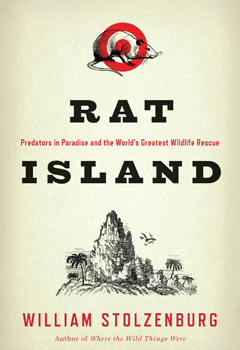 Rat Island: Predators in Paradise and the World’s Greatest Wildlife Rescue
Rat Island: Predators in Paradise and the World’s Greatest Wildlife Rescue
by William Stolzenburg
Bloomsbury (2011), $26
For city dwellers, rats are a nuisance and a health hazard. But for isolated island species, rats are a death sentence, as William Stolzenburg demonstrates in his new book, Rat Island.
Stolzenburg begins his story 700 years ago, when Polynesians set out to explore the islands of Oceania, and brought their kiore rats with them for sustenance. During the following centuries, rats arrived on the pristine islands, intentionally and unintentionally. But for the seafaring rats, intent made no difference. They began to out-compete native island species—especially birds, who were unadapted for land-based prey. Slowly, the rats drove almost all of the birds to extinction by both preying on them and occupying their habitat.
It’s the optimistic “almost” that Stolzenburg captures here. By aerially dropping tons of poison onto a few test islands to kill the rats, conservationists have finally made headway in the centuries-old battle. Using the New Zealand kakapo and the least auklet on the Bering Sea’s Kiska Island as examples, Stolzenburg tells of both historical and contemporary efforts to contain the rats and preserve native bird species.
This newest weapon, however, is not without controversy. Using poison has allowed conservationists to reclaim islands around the world, but others question the decision to kill populations of any species en masse. With engaging writing and a knack for historical storytelling, Stolzenburg prods the reader to consider the role of humans in ecological evolution, and our role as stewards and saviors.
– Katherine Silkaitis



